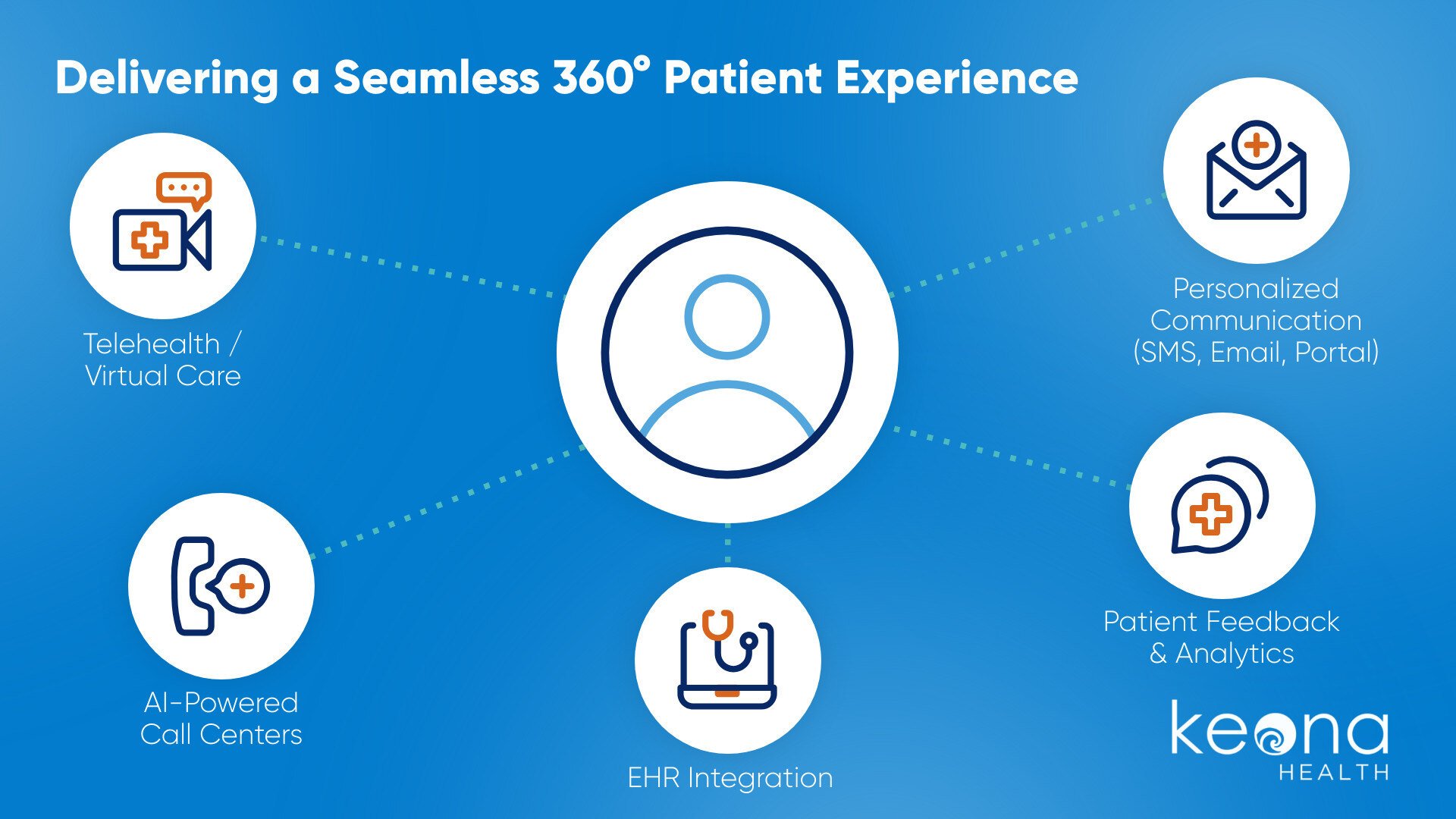
The state of patient service in 2025
Maria had grappled with shortness of breath for weeks. When she called her healthcare provider, she was shuffled three times, repeated her information each time,
and endured 47 minutes on the phone, only to secure an appointment three weeks later. Discouraged and anxious, she hung up, feeling like just another number in a system that didn't see her as a person.
Two months later, after her provider activated a patient experience analytics system, Maria called again about recurring symptoms. This time, the agent greeted her by name, knew her previous concerns, and connected her to a triage nurse who assessed her symptoms and locked in a next-day appointment. The difference was remarkable—for the first time, she felt truly heard.
The Crossroads of Care and Connection
In 2025, healthcare is at a pivotal intersection. Medical knowledge and technology surge forward, yet the human experience of receiving care lags behind. Patients like Maria navigate a maze of disconnected systems while carrying their health concerns—a journey often leaving them exhausted and dissatisfied.
Healthcare providers share this frustration. Many clinicians entered the field to help people but often find themselves in systems that make meaningful connection nearly impossible—drowning in data yet starving for insights to truly understand their patients.
This disconnect isn't just troubling from a compassion standpoint—it's a growing business liability. As healthcare becomes more value-based, patient experience directly impacts reimbursement rates and organizational sustainability.
Seeing the Whole Person: The Power of Patient Experience Analytics
Patient experience analytics weaves together threads of a patient's journey—from their first anxious call to their post-treatment recovery—into a cohesive tapestry revealing patterns invisible to the naked eye.
Consider Ellen, an 84-year-old grandmother who missed three appointments in two months. Traditional systems might label her "non-compliant." But with patient experience analytics, they uncovered Ellen's missed appointments coincided with transportation issues. A simple scheduling adjustment unraveled what clinical notes couldn't reveal.
This approach isn't just about collecting more data—it's about understanding the human story behind the numbers. At its core, patient experience analytics gathers and deciphers data from all facets of the patient's journey, from first contact with a call center agent to post-treatment follow-up.
It combines structured information like satisfaction surveys and clinical outcomes with unstructured elements like call transcripts and online reviews. Information from mobile apps can provide valuable experiential insights. Advanced analytics like machine learning and natural language processing transform this raw material into actionable insights that allow providers to see patients holistically.
The Business of Caring: Why Experience Matters to the Bottom Line
When healthcare organizations prioritize patient experience, the financial results are compelling. It's not just about patient satisfaction—it's about sustainable business performance.
Kaufman Hall 2023 research demonstrates organizations delivering exceptional patient experiences achieve significantly higher net margins compared to those offering average experiences. This aligns with the broader trend of enhanced patient engagement leading to better financial outcomes for healthcare providers (HHM Global). Similarly, the American Hospital Association's 2023 report shows providers with higher patient experience scores maintain better financial stability even during economic downturns.
Better patient experience analytics delivers:
- Deeper patient loyalty in a competitive market—Accenture research shows 78% of healthcare consumers would switch providers for a better experience, making each interaction crucial to retention.
- Improved clinical outcomes—Corewell Health slashed 30-day readmissions by 26% using predictive analytics to identify at-risk patients.
- Greater alignment with value-based care goals—with Forrester reporting that 7 in 10 payers tie provider compensation directly to patient experience scores
Building Your Patient-Centered Analytics Foundation
Creating a patient experience analytics program is like building a house—it requires a solid foundation, the right tools, and a clear vision of the final structure.
Start by inventorying existing patient data sources. Many discover they're using only a fraction of the experience data they're gathering—sitting on a goldmine of insights without realizing it.
The process requires four components:
First, consolidate your data in a centralized repository. Don't just focus on structured data—mine unstructured sources like call recordings and medical notes as well.
Second, select the right analytics platform with robust integration and real-time capabilities.
Third, secure buy-in from leadership and staff. Educate the organization on the significance of patient experience analytics. BJC Healthcare offers a compelling case—after appointing a Chief Patient Experience Officer and creating a dedicated analytics team, their HCAHPS scores rose from the 44th to 84th percentile.
Finally, act on the insights. Share digestible analytics with point-of-care staff and collaborate on improvement initiatives. When Advocate Aurora armed clinicians with real-time patient experience dashboards, care coordination scores soared 215%.
The Art of Personalization: From Data to Relationship
Personalization used to mean addressing patients by name. Today, it means understanding each person's unique needs, then tailoring every interaction accordingly.
One of the biggest opportunities in patient experience analytics lies in leveraging data to tailor care to each individual. Predictive analytics enables providers to pinpoint patients at risk of missing appointments or requiring readmission. Real-time analytics brings precision to patient interactions, with sentiment analysis tools detecting frustration during support calls and suggesting de-escalation tactics.
Intelligent call routing can match patients with the agent best suited to their personality for optimal rapport. These capabilities aren't about replacing human connection—they're about fostering more meaningful interactions by providing staff with the right information at the right time.
ChenMed combines experience analytics with clinical data to create hyper-personalized care plans for Medicare patients. The result: 50% fewer hospital admissions compared to national averages. By making each patient feel understood and valued, providers can boost outcomes while earning long-term loyalty.
Beyond the Walls: Extending Care to Daily Life
Healthcare doesn't end when patients leave the facility. To elevate the patient experience, analytics and engagement efforts must extend beyond the four walls of the clinic.
For patients with risk factors for readmission, analytics can trigger personalized follow-up protocols—check-in calls, educational materials, and digital support tools addressing recovery challenges.
Leading healthcare organizations are mining experience data to proactively connect with patients at home. Post-discharge callbacks and surveys can uncover recovery obstacles before they cause costly readmissions.
This approach transforms post-discharge interactions from tasks into opportunities for meaningful support. Enhanced first call resolution to common phone inquiries liberates staff to focus on complex cases requiring expertise and compassion.
The Future of Patient Experience Analytics
Today's patient experience analytics are revolutionizing care, and emerging technologies promise more profound possibilities.
IoT devices will capture behavioral and biometric data, painting a more vivid picture of patient well-being. Federated learning will enable providers to share insights across systems while preserving privacy. Blockchain will empower patients to own their experience data and share it selectively with providers for hyper-personalization. Digital twin simulations will allow healthcare organizations to model how operational changes might affect patient experience metrics before implementation.
According to Grand View Research, the patient experience analytics market will soar to $3.5 billion by 2027—reflecting recognition that understanding patients as people is compassionate care and smart business.
The Choice Before Us
As healthcare becomes competitive and consumer-driven, patient experience analytics is shifting from a nice-to-have to a necessity. Organizations face a choice: Will they embrace the power of patient experience analytics to truly understand the humans they serve? Or will they continue treating patients as data points in standardized processes?
Those who harness the vast volumes of experience data flowing in from diverse sources will finally understand their patients: their needs, their preferences, their challenges. With those insights, they can craft processes, train staff, and leverage technology to deliver empathetic, personalized care experiences that improve outcomes and inspire loyalty.
While implementing an experience analytics program requires investment and commitment, the ROI is clear. Enhanced metrics around satisfaction, outcomes, and utilization fuel a healthier bottom line.
The question isn't whether patient experience analytics will revolutionize healthcare—it's whether your organization will spearhead the future of care delivery or be left behind as competitors wield experience insights to attract and retain your patient base.
Ready to explore how patient experience analytics can transform your organization? Our team specializes in implementing healthcare analytics solutions that improve both patient and business outcomes. Contact us today for a free consultation.
For an in-depth exploration of key metrics for healthcare call centers, download our complimentary guide, “The 15 Key Patient Experience Metrics For Success.”
Posted By

Stephen Dean is COO of Keona Health, where he’s spent 13 years building AI systems that transform patient access. Before “agentic AI” was a term, his team was deploying autonomous systems that now handle millions of patient conversations annually.
Related Post
August 10, 2023
why the staffing trap cripples your patient engagement strategy you wait for a...


